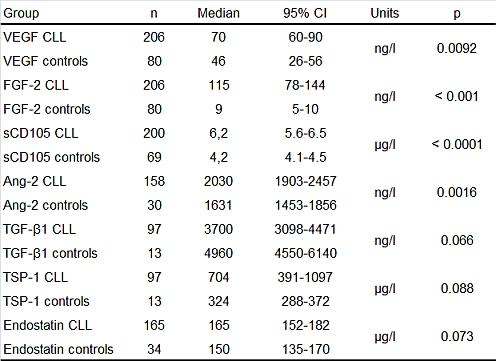COMPLEX ACTIVATION OF ANGIOGENIC SIGNALING IN CHRONIC LYMPHOCYTIC LEUKEMIA: EVIDENCE FROM CIRCULATING ANGIOGENIC CYTOKINES.
(Abstract release date: 05/19/16)
EHA Library. Smolej L. 06/09/16; 134693; PB1793

Dr. Lukáš Smolej
Contributions
Contributions
Abstract
Abstract: PB1793
Type: Publication Only
Background
Angiogenesis is an important and well-known player in the biology of chronic lymphocytic leukemia. Elevated plasma/serum concentrations of various angiogenic cytokines have been reported in CLL; however, their exact prognostic role, association with modern prognostic factors and impact on clinical course (especially overall survival) is largely unknown.
Aims
To evaluate prognostic significance of vascular endothelial growth factor (VEGF), fibroblast growth factor-2 (FGF-2), soluble endoglin (sCD105), angiopoietin-2 (Ang-2), transforming growth factor-1 (TGF-β1) and inhibitors endostatin and thrombospondin-1 (TSP-1) in patients with untreated CLL followed at a single tertiary center.
Methods
Plasma levels of VEGF, FGF-2, sCD105, Ang-2, TGF-β1, endostatin and TSP-1 were quantified using enzyme-linked immunosorbent assay (ELISA Quantikine kits, RD Systems) in 206 patients with CLL (median age, 64 year; males, 69%; Rai modified risk: low/intermediate/high in 38/46/16%; unmutated IGVH genes, 58%; del 11q/del 17p by FISH, 19 and 4%) and 80 healthy controls. Plasma concentrations ≥ median of the CLL cohort were considered elevated.
Results
VEGF, FGF-2, sCD105 and Ang-2 were significatly elevated in comparison to the control group; differences in TGF-β1, endostatin and TSP-1 were on the border of statistical significance (Table 1). There was a positive association of high Ang-2 with unmutated IGHV genes (p=0.027); patients with high sCD105 and lowTGF-β1 had more advanced Rai stages (p=0.0004 and p=0.052). High levels of Ang-2, endostatin, sCD105 and low TGF-β1 correlated with shorter time to first-line therapy (p=0.0001, p=0.0001, p=0.0021 and p=0.027); in addition, patients with high Ang-2 and endostatin had significantly shorter overall survival (p=0.0006 and p=0.015).
Conclusion
Our results indicate that a complex network of angiogenic signaling is active in CLL and has an impact on clinical course; Ang-2 and endostatin appear to possess the best prognostic value and deserve further evaluation. Supported by DRO (Univ Hospital Hradec Králové, 00179906).

Session topic: E-poster
Keyword(s): Angiogenesis, Chronic lymphocytic leukemia, Prognosis
Type: Publication Only
Background
Angiogenesis is an important and well-known player in the biology of chronic lymphocytic leukemia. Elevated plasma/serum concentrations of various angiogenic cytokines have been reported in CLL; however, their exact prognostic role, association with modern prognostic factors and impact on clinical course (especially overall survival) is largely unknown.
Aims
To evaluate prognostic significance of vascular endothelial growth factor (VEGF), fibroblast growth factor-2 (FGF-2), soluble endoglin (sCD105), angiopoietin-2 (Ang-2), transforming growth factor-1 (TGF-β1) and inhibitors endostatin and thrombospondin-1 (TSP-1) in patients with untreated CLL followed at a single tertiary center.
Methods
Plasma levels of VEGF, FGF-2, sCD105, Ang-2, TGF-β1, endostatin and TSP-1 were quantified using enzyme-linked immunosorbent assay (ELISA Quantikine kits, RD Systems) in 206 patients with CLL (median age, 64 year; males, 69%; Rai modified risk: low/intermediate/high in 38/46/16%; unmutated IGVH genes, 58%; del 11q/del 17p by FISH, 19 and 4%) and 80 healthy controls. Plasma concentrations ≥ median of the CLL cohort were considered elevated.
Results
VEGF, FGF-2, sCD105 and Ang-2 were significatly elevated in comparison to the control group; differences in TGF-β1, endostatin and TSP-1 were on the border of statistical significance (Table 1). There was a positive association of high Ang-2 with unmutated IGHV genes (p=0.027); patients with high sCD105 and lowTGF-β1 had more advanced Rai stages (p=0.0004 and p=0.052). High levels of Ang-2, endostatin, sCD105 and low TGF-β1 correlated with shorter time to first-line therapy (p=0.0001, p=0.0001, p=0.0021 and p=0.027); in addition, patients with high Ang-2 and endostatin had significantly shorter overall survival (p=0.0006 and p=0.015).
Conclusion
Our results indicate that a complex network of angiogenic signaling is active in CLL and has an impact on clinical course; Ang-2 and endostatin appear to possess the best prognostic value and deserve further evaluation. Supported by DRO (Univ Hospital Hradec Králové, 00179906).

Session topic: E-poster
Keyword(s): Angiogenesis, Chronic lymphocytic leukemia, Prognosis
Abstract: PB1793
Type: Publication Only
Background
Angiogenesis is an important and well-known player in the biology of chronic lymphocytic leukemia. Elevated plasma/serum concentrations of various angiogenic cytokines have been reported in CLL; however, their exact prognostic role, association with modern prognostic factors and impact on clinical course (especially overall survival) is largely unknown.
Aims
To evaluate prognostic significance of vascular endothelial growth factor (VEGF), fibroblast growth factor-2 (FGF-2), soluble endoglin (sCD105), angiopoietin-2 (Ang-2), transforming growth factor-1 (TGF-β1) and inhibitors endostatin and thrombospondin-1 (TSP-1) in patients with untreated CLL followed at a single tertiary center.
Methods
Plasma levels of VEGF, FGF-2, sCD105, Ang-2, TGF-β1, endostatin and TSP-1 were quantified using enzyme-linked immunosorbent assay (ELISA Quantikine kits, RD Systems) in 206 patients with CLL (median age, 64 year; males, 69%; Rai modified risk: low/intermediate/high in 38/46/16%; unmutated IGVH genes, 58%; del 11q/del 17p by FISH, 19 and 4%) and 80 healthy controls. Plasma concentrations ≥ median of the CLL cohort were considered elevated.
Results
VEGF, FGF-2, sCD105 and Ang-2 were significatly elevated in comparison to the control group; differences in TGF-β1, endostatin and TSP-1 were on the border of statistical significance (Table 1). There was a positive association of high Ang-2 with unmutated IGHV genes (p=0.027); patients with high sCD105 and lowTGF-β1 had more advanced Rai stages (p=0.0004 and p=0.052). High levels of Ang-2, endostatin, sCD105 and low TGF-β1 correlated with shorter time to first-line therapy (p=0.0001, p=0.0001, p=0.0021 and p=0.027); in addition, patients with high Ang-2 and endostatin had significantly shorter overall survival (p=0.0006 and p=0.015).
Conclusion
Our results indicate that a complex network of angiogenic signaling is active in CLL and has an impact on clinical course; Ang-2 and endostatin appear to possess the best prognostic value and deserve further evaluation. Supported by DRO (Univ Hospital Hradec Králové, 00179906).

Session topic: E-poster
Keyword(s): Angiogenesis, Chronic lymphocytic leukemia, Prognosis
Type: Publication Only
Background
Angiogenesis is an important and well-known player in the biology of chronic lymphocytic leukemia. Elevated plasma/serum concentrations of various angiogenic cytokines have been reported in CLL; however, their exact prognostic role, association with modern prognostic factors and impact on clinical course (especially overall survival) is largely unknown.
Aims
To evaluate prognostic significance of vascular endothelial growth factor (VEGF), fibroblast growth factor-2 (FGF-2), soluble endoglin (sCD105), angiopoietin-2 (Ang-2), transforming growth factor-1 (TGF-β1) and inhibitors endostatin and thrombospondin-1 (TSP-1) in patients with untreated CLL followed at a single tertiary center.
Methods
Plasma levels of VEGF, FGF-2, sCD105, Ang-2, TGF-β1, endostatin and TSP-1 were quantified using enzyme-linked immunosorbent assay (ELISA Quantikine kits, RD Systems) in 206 patients with CLL (median age, 64 year; males, 69%; Rai modified risk: low/intermediate/high in 38/46/16%; unmutated IGVH genes, 58%; del 11q/del 17p by FISH, 19 and 4%) and 80 healthy controls. Plasma concentrations ≥ median of the CLL cohort were considered elevated.
Results
VEGF, FGF-2, sCD105 and Ang-2 were significatly elevated in comparison to the control group; differences in TGF-β1, endostatin and TSP-1 were on the border of statistical significance (Table 1). There was a positive association of high Ang-2 with unmutated IGHV genes (p=0.027); patients with high sCD105 and lowTGF-β1 had more advanced Rai stages (p=0.0004 and p=0.052). High levels of Ang-2, endostatin, sCD105 and low TGF-β1 correlated with shorter time to first-line therapy (p=0.0001, p=0.0001, p=0.0021 and p=0.027); in addition, patients with high Ang-2 and endostatin had significantly shorter overall survival (p=0.0006 and p=0.015).
Conclusion
Our results indicate that a complex network of angiogenic signaling is active in CLL and has an impact on clinical course; Ang-2 and endostatin appear to possess the best prognostic value and deserve further evaluation. Supported by DRO (Univ Hospital Hradec Králové, 00179906).

Session topic: E-poster
Keyword(s): Angiogenesis, Chronic lymphocytic leukemia, Prognosis
{{ help_message }}
{{filter}}


